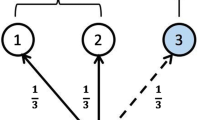Abstract
Along with the advance of internet and fast updating of information, nowadays it is much easier to search and acquire scientific publications. To identify the high quality articles from the paper ocean, many ranking algorithms have been proposed. One of these methods is the famous PageRank algorithm which was originally designed to rank web pages in online systems. In this paper, we introduce a preferential mechanism to the PageRank algorithm when aggregating resource from different nodes to enhance the effect of similar nodes. The validation of the new method is performed on the data of American Physical Society journals. The results indicate that the similarity-preferential mechanism improves the performance of the PageRank algorithm in terms of ranking effectiveness, as well as robustness against malicious manipulations. Though our method is only applied to citation networks in this paper, it can be naturally used in many other real systems, such as designing search engines in the World Wide Web and revealing the leaderships in social networks.






Similar content being viewed by others
References
Aksnes, D. W. (2003). A macro study of self-citation. Scientometrics, 56(2), 235–246.
Bergstrom, C. T. (2007). Eigenfactor: Measuring the value and prestige of scholarly journals. College and Research Libraries News, 68(5), 314–316.
Bergstrom, C. T., & West, J. D. (2008). Assessing citations with the eigenfactor (TM) metrics. Neurology, 71(23), 1850–1851.
Bollen, J., Rodriquez, M. A., & Van de Sompel, H. (2006). Journal status. Scientometrics, 69(3), 669–687.
Brin, S., & Page, L. (1998). The anatomy of a large-scale hypertextual Web search engine. Computer Networks and ISDN Systems, 30(1–7), 107–117.
Chen, P., Xie, H., Maslov, S., & Redner, S. (2007). Finding scientific gems with Google’s PageRank algorithm. Journal of Informetrics, 1(1), 8–15.
Ding, Y. (2011). Applying weighted PageRank to author citation networks. Journal of the American Society for Information Science and Technology, 62(2), 236–245.
Ding, Y., Yan, E., Frazho, A., & Caverlee, J. (2009). PageRank for ranking authors in co-citation networks. Journal of the American Society for Information Science and Technology, 60(11), 2229–2243.
Fersht, A. (2009). The most influential factors: Impact factor and eigenfactor. Proceedings of the National Academy of Sciences of the United States of America, 106, 6883–6884.
Fiala, D. (2012). Time-aware PageRank for bibliographic networks. Journal of Informetrics, 6(3), 370–388.
Fiala, D., Rousselot, F., & Ježek, K. (2008). Pagerank for bibliographic networks. Scientometrics, 76(1), 135–158.
Foley, J., & Della Sala, S. (2010). The impact of self-citation. Cortex, 46(6), 802–810.
Frey, B. S., & Rost, K. (2010). Do rankings reflect research quality? Journal of Applied Economics, 13(1), 1–38.
Frobenius, G. (1912). Über Matrizen aus nicht negativen Elementen. Königliche Akademie der Wissenschaften.
González-Pereira, B., Guerrero-Bote, V. P., & Moya-Anegón, F. (2010). A new approach to the metric of journals’ scientific prestige: The SJR indicator. Journal of Informetrics, 4(3), 379–391.
Guimerà, R., & Sales-Pardo, M. (2009). Missing and spurious interactions and the reconstruction of complex networks. Proceedings of the National Academy of Sciences, 106(52), 22073–22078.
Ioannidis, J. P. (2015). A generalized view of self-citation: Direct, co-author, collaborative, and coercive induced self-citation. Journal of Psychosomatic Research, 78(1), 7–11.
Lü, L., & Zhou, T. (2011). Link prediction in complex networks: A survey. Physica A: Statistical Mechanics and its Applications, 390(6), 1150–1170.
Ma, N., Guan, J., & Zhao, Y. (2008). Bringing PageRank to the citation analysis. Information Processing and Management, 44(2), 800–810.
Maslov, S., & Redner, S. (2008). Promise and pitfalls of extending Google’s PageRank algorithm to citation networks. The Journal of Neuroscience, 28(44), 11103–11105.
Nykl, M., Ježek, K., Fiala, D., & Dostal, M. (2014). PageRank variants in the evaluation of citation networks. Journal of Informetrics, 8(3), 683–692.
Perron, O. (1907). Zur theorie der matrices. Mathematische Annalen, 64(2), 248–263.
Radicchi, F., Fortunato, S., & Castellano, C. (2008). Universality of citation distributions: Toward an objective measure of scientific impact. Proceedings of the National Academy of Sciences, 105(45), 17268–17272.
Radicchi, F., Fortunato, S., Markines, B., & Vespignani, A. (2009). Diffusion of scientific credits and the ranking of scientists. Physical Review E, 80(5), 056103.
Sorzano, C. O. S., Vargas, J., Caffarena-Fernández, G., & Iriarte, A. (2014). Comparing scientific performance among equals. Scientometrics, 101(3), 1731–1745.
Su, C., Pan, Y., Zhen, Y., Ma, Z., Yuan, J., Guo, H., et al. (2011). PrestigeRank: A new evaluation method for papers and journals. Journal of Informetrics, 5(1), 1–13.
Walker, D., Xie, H., Yan, K. K., & Maslov, S. (2007). Ranking scientific publications using a model of network traffic. Journal of Statistical Mechanics: Theory and Experiment, 2007(06), P06010.
Yan, E. (2014). Topic-based PageRank: Toward a topic-level scientific evaluation. Scientometrics, 100(2), 407–437.
Yan, E., & Ding, Y. (2011). Discovering author impact: A PageRank perspective. Information processing and management, 47(1), 125–134.
Yao, L., Wei, T., Zeng, A., Fan, Y., & Di, Z. (2014). Ranking scientific publications: The effect of nonlinearity. Scientific Reports, 4, 6663.
Zeng, A., & Cimini, G. (2012). Removing spurious interactions in complex networks. Physical Review E, 85(3), 036101.
Acknowledgments
This work is supported by the National Natural Science Foundation of China under Grant Nos. 61374175, 61174150 and 11547188, the Young Scholar Program of Beijing Normal University (2014NT38).
Author information
Authors and Affiliations
Corresponding authors
Electronic supplementary material
Below is the link to the electronic supplementary material.
Rights and permissions
About this article
Cite this article
Zhou, J., Zeng, A., Fan, Y. et al. Ranking scientific publications with similarity-preferential mechanism. Scientometrics 106, 805–816 (2016). https://doi.org/10.1007/s11192-015-1805-1
Received:
Published:
Issue Date:
DOI: https://doi.org/10.1007/s11192-015-1805-1




